Seiko has quite the history - and current penchant - of doing things that are out of the ordinary. Whether it be their longstanding tradition of dial artistry, incredible variety of case shapes and sizes, movement innovations, or even having two competing production and design factories back in the day, it stands to reason that if there’s something different that can be done in the world of watches, Seiko will be giving it a go.
While many of Seiko’s developments have continued to be in their production lines, such as Hi-Beat and Spring Drive movements and the intricate art-like dials, others have fallen away as a sign of the times. One wacky sign of the ‘70s that I am in love with, and wish would return, is the faceted crystal: a certified funktastic piece of watch lore that instantaneously makes any watch the most interesting watch in the world. For those new to these types of crystals, they are typically thicker cuts that your average flat or domed crystals, and they have an easily identifiable sequence of cuts, or facets, that create multiple angles and depth planes on the surface of the watch. As a result, these crystals produce the most incredible light-play, like in the picture below:

Watch design, and the directions that watch brands decide to pursue, ebb and flow with the times. Bigger watches are in, and then they’re out, and then they’re back in again. Blue dials are all the rage, then green, then black, then back to blue, then textured, then matte, then glossy…you get the idea. Trends and patterns of watch design will always be a developmental progression, and when certain eras come and go, the watch community has time to look back and reflect on what’s been left behind.
Faceted crystals had been, definitively, left behind, both from a production standpoint and from a popularity standpoint. Scrolling through forum threads and article comments maybe 20 years ago, it was easy to find comment after comment saying “ew,” “yuck,” “thank god that’s in the past,” “weird,” and so on when it came to faceted crystals. Fast-forward to the present day, and these same types of write-ups and posts are swimming in positivity, with these wonky crystals - and the equally wonky watches that came with them - experiencing a bit of a renaissance for modern watch culture.
Unlike most trends that reemerge, I believe that this one has a fairly simple reasoning behind it: watches are fun again.
Sure, there are a million-and-one stiffs out there who will only look at or “approve of” watches of a certain stature - the luxury bros - but that dynamic comes with any hobby and doesn’t represent the whole lot. I see watches as being fun again largely due to a) microbrands providing affordable, risk-taking designs, b) major brands like Seiko, and by extension Grand Seiko, Breitling, and even Tag Heuer pushing their own product catalogues with new designs or colorful reissues, and c) three current generations of watch-wearers looking for new ways to express themselves at a variety of price points. So, since we’re having fun (and in a genuine way, not in the way of an angry parent at Disney shouting at their nine children in matching tie-dye t-shirts that “THIS IS FUN WE ARE HAVING FUN SEE YOU GOT WHAT YOU WANT THIS IS FUN”…big yikes), let’s take a closer look at these crystals, their history, and why I would love to see them make a modern comeback.
By complete coincidence, each of the three watches I have with faceted crystals are from 1973…and I definitely just realized this as I was writing up this article. But I this speaks to the peak age for these types of watches, as the early ‘70s were, similar to today, a time for pushing design boundaries and testing out ideas that were a bit more out there. When it comes to Seiko, this wasn’t so much a desire as it was an inherent need, as both the Daini and Suwa factories were hard at work pushing each other to innovate and surpass the other. What I would give to be able to travel back in time and see the processes of each Seiko faction, how they operated under one brand but so completely siloed, and, maybe most of all, how many ideas were proposed and even maybe in partial production before getting the can. If watches like the ones I have here made the cut, can we even imagine the potentially insane designs that did not? Barring the discovery of some buried chest of secrets lurking somewhere in Nagano, we’ll likely never know.
Two of the watches I have here are from the Daini Seikosha factory, while one is from the Suwa Seikosha side. It’s quite easy, thankfully, so deduce where each piece of this era would have come from which production site, as Daini and Suwa would stamp the dials with their own logo variation:
Both the Chariot and the Advan come from the former, while the Lord Matic comes from the latter. It’s amazing to think that each of these was produced in the same year, by the same brand, and emerged so differently.
Even without the faceted crystal, this watch would have been a bit of an outlandish design. Thinking of the beautiful simplicity present in many other vintage Seiko references, such as linen-dialed Lord Marvels or the 45-7000 King Seiko, and then looking at this Advan, it’s easy to wonder (internally or aloud) who in the world decided to do this? Whoever it was, I’m sure glad they did. Two-tone indices, hands that look like they belong in the movie Treasure Planet, the Advan sun dial stamp, and an ocean of sunburst dial coloration make this watch an already ambitious proposition. This watch in particular shares many of the outrageous details that have made the King Seiko Vanac series such a set of cult icons (have fun jumping down the Vanac rabbit hole now, and you’re welcome!). Add the faceted crystal into the equation and this piece becomes straight up over-the-top, which makes sense for its era of production, oddly enough. The crystal really became one of Seiko’s cherry on top type of spec additions, and though there were other brands who dabbled in faceted crystals at the time - Rado, as an example - it was Seiko who pushed this design element through the decade.
The next piece from Daini is this Seiko Chariot, which I’ve decided to name the “Desert Dial.” Whereas the Advan took a number of design elements that wouldn’t seem to fit together and made them work as one package, this Chariot strikes me as a deliberate attempt to convey a specific landscape through the watch’s construction. The dial has a sand-colored, wavy texture, almost akin to the modern day White Birch reference. The hands, indices, and raised Seiko text are all gold, and the crystal itself, beyond having five angles to it, is raised to a curve as it makes its way around the case.
Each of these pieces put together gives me an image of large, sandy dunes, with the crystal creating a mirage effect depending on how the watch is viewed. It’s the type of imagery play that is seldom seen in a modern watch, but one I can see Seiko/Grand Seiko bringing back more and more as new watches are released.
The last of the three faceted crystal pieces here is that from the Suwa side - a 1973 Seiko Lord Matic (5606-7281):
This LM has a cross-sectional dial pattern that changes its blue colorway depending on the lighting, angle of the crystal, and which of the crystal sections is being used to view the watch. The lighter blue portion of the dial in the middle is brushed horizontally, while the darker portions are brushed vertically; even with a flat or domes crystal, this dial would be something else, but similar to the other two pieces, I believe the faceted crystal was a deliberate sign choice to add additional dynamism. When it really comes down to it, that’s what these funky crystals were: elements of design deployed when the watch itself called for a little something extra.
Despite the incredibly ingenuity of these designs, faceted crystals were more of less unceremoniously relegated to shelves and storehouses as the ‘80s came through. Part of this was strictly practical, as the crystals themselves were an easy scratch target for any door, desk, or stationary object. Replacing them was also no one’s favorite process, as they were not widely available and many faceted crystals would only be compatible with certain references. For the headaches caused, the declining interest, and a change of the times, faceted crystals took a back seat for decades to…well, every other type of crystal. That is, until about 2006, when Seiko brought back the faceted crystal for three varieties of the SARB005.
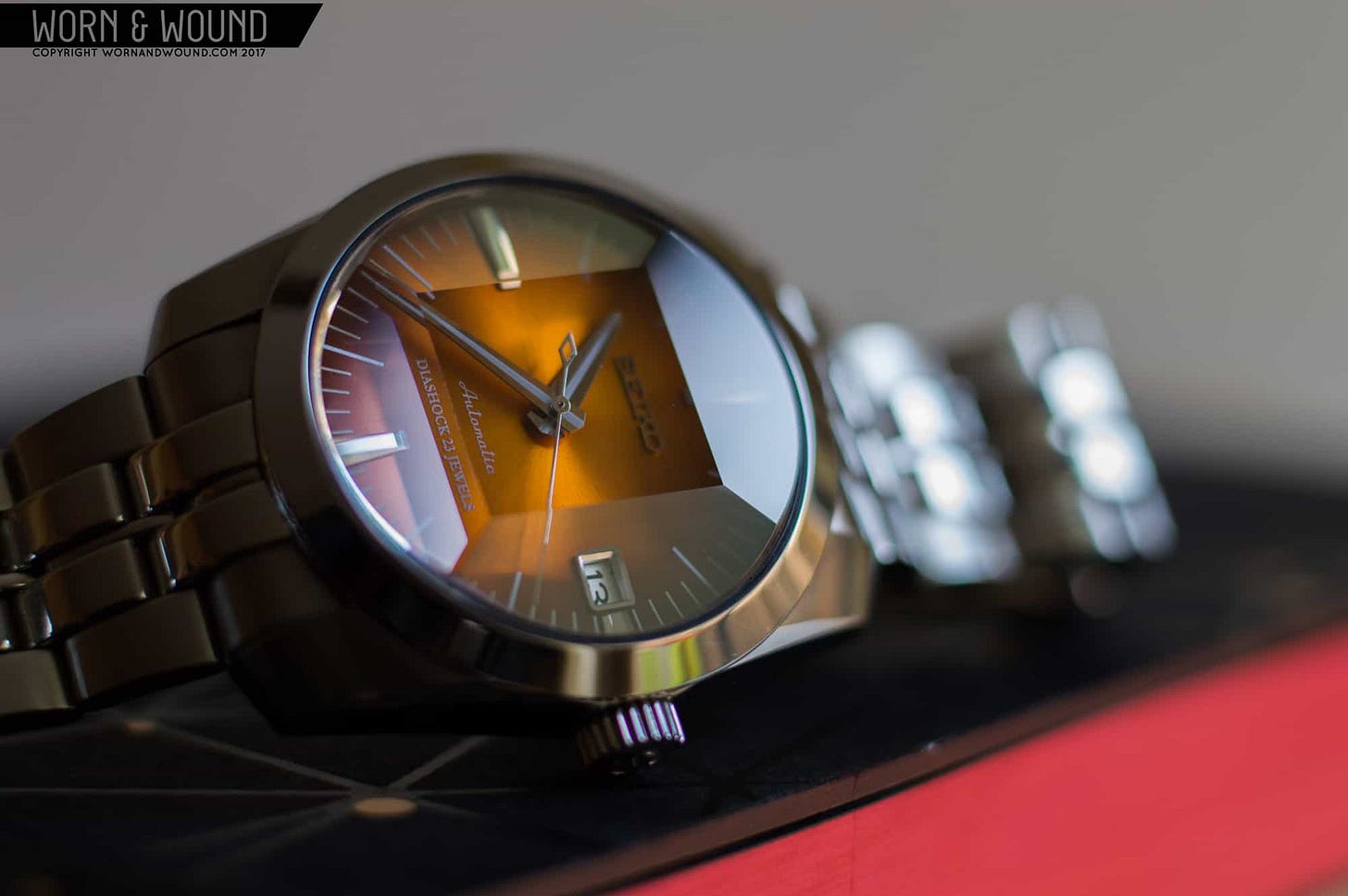
These watches were snapped up and into the wind before most could even try to buy them, lifting the lid on a faction of watch enthusiasm that had seemingly been on a low boil for some time. There was a small but mighty group of folks who continued to love these funky crystals - showing as much when this piece was released - and now we’re seeing this excitement for ‘70s funk bumping up once again. Shout out to the microbrand Horage as well, which actually released a watch with a gorgeous faceted crystal not too long ago!
This brings me to the last part of this article:
Which watches of today could use a faceted crystal?
That would be a list way too long for anyone’s attention span, so I’m going to boil it down to two very distinct watches that, to me, represent similar aesthetic waves from two brands that could not be further apart.
To start, this would be an absolute must-have:
The Grand Seiko Hi-Beat 36000 GMT (SBGJ259). Released this summer as a U.S. special edition, I would absolutely lose my mind if this had a faceted crystal. The texture of the dial in vertical bamboo likeness, razor sharp hands and indices, and a GMT??? All with a new inclusion of faceted funk? Sign me up and take my money. Besides the aesthetic appeal, this watch would also make for an enthusiast’s dream piece, combining a lost art of design with all of the innovations of the modern day movements, production, detail, and brand development for which Grand Seiko is so beloved.
On a scale of “would this happen,” low-high 1-10, I’ll give this GS an 8. I’m convinced that all some of these GS pieces really need when it comes to including a faceted crystal is an over-caffeinated lunatic advocate in the room.
…it’s me. I’m the over-caffeinated lunatic advocate. Hey Grand Seiko, call me!
Next up on my fantasy draft is a watch that would never in a million years get the faceted crystal treatment; the brand wouldn’t go for it, nope nope and nope. But in the words of Matthew McConaughey, “it’d be a lot cooler if you did.”
The Milgauss. Specifically, the 116400GV. I mean, come ON!!! It has a LIGHTNING BOLT SECOND HAND. How much funkier could it be? Well, the answer is just a little bit more funky. The Milgauss, with its colored crystal, colored dial, colored outer track numerals, colored “MILGAUSS” dial print, and yes, the colored lighting bolt hand, would be an absolute slam dunk of a faceted crystal candidate. Think back to the Seiko Advan for reference:
You take an already outlandish Milgauss design and add a faceted crystal, and what we’ll have is arguably the most fun Rolex watch ever produced. You think the Rainbow Daytona was wild? I’ll raise you one. You pulling the lefty GMT out of your back pocket? Psh, please. This Milgauss would smoke that and you know it.
…okay I now realize I’m defending a little too aggressively a watch that does not exist. In fact, let’s see where it would fall on my 1-10 scale!
0.
Big fat 0.
Why? Because Rolex is far removed from the days of experimenting with their watches when it comes to materials and layouts (and no, putting gems on existing models doesn’t count). Designs are adjusted, but not changed; it’s just not the Rolex way. I can’t see a watch world where Rolex goes full ‘70s and puts a green-hued, faceted crystal on their Milgauss. Maybe even more than the Grand Seiko, the Milgauss is the watch I would love to see the most with this extra layer of…extra. Like I said, I give it a 0 on the likelihood scale, but hey, a guy can dream.
Fortunately, despite the modern reluctance to bring faceted crystals back, vintage Seiko continues to come through, and you can still find pieces like these floating around out there! Just be sure to double, triple, and quadruple check your buying source and references numbers…plenty of Feikos out there still.
Happy hunting folks, and as always, wherever you are, and wherever you’re going, many thanks for stopping by.

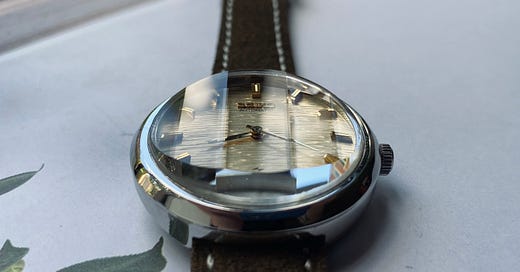




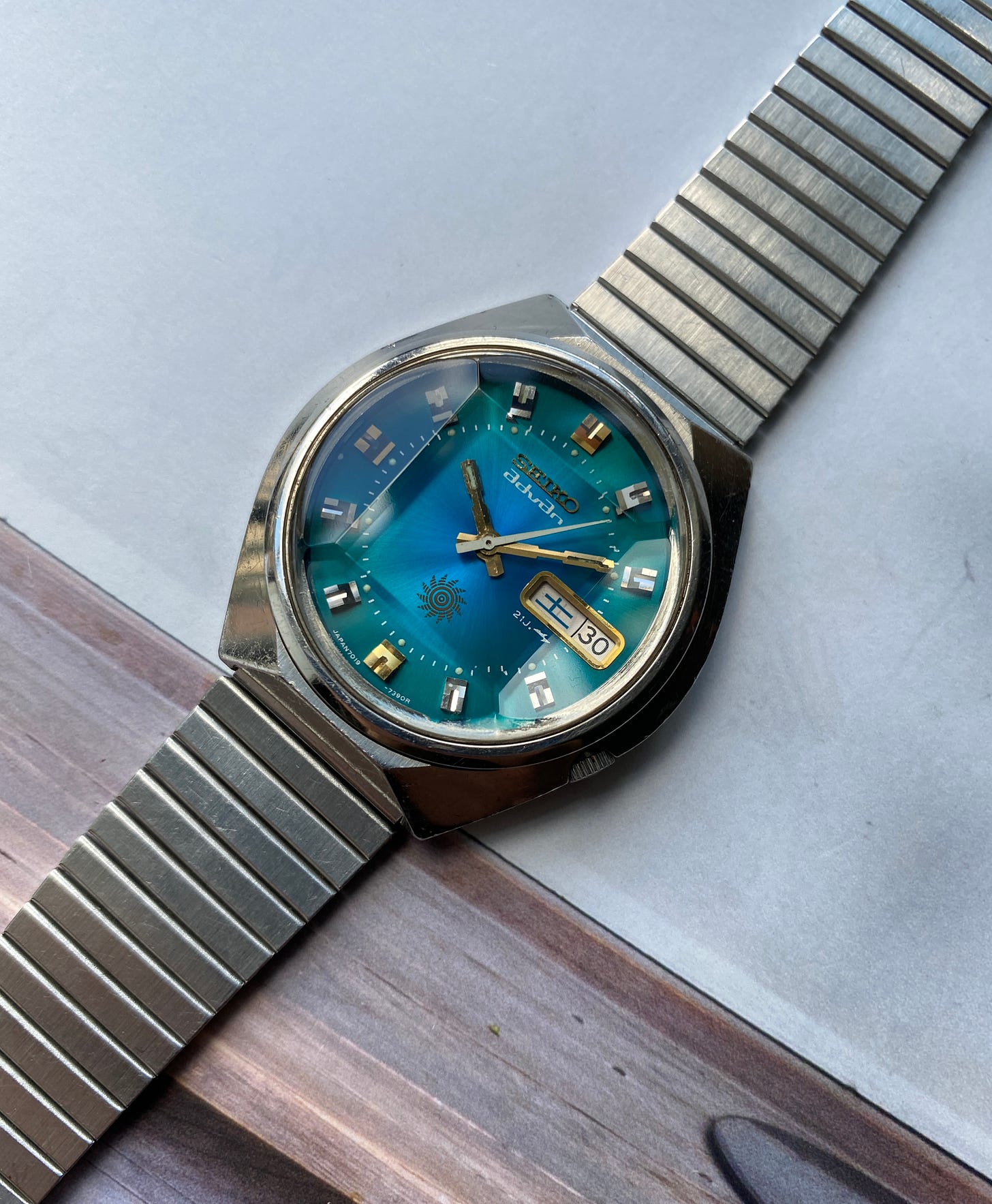
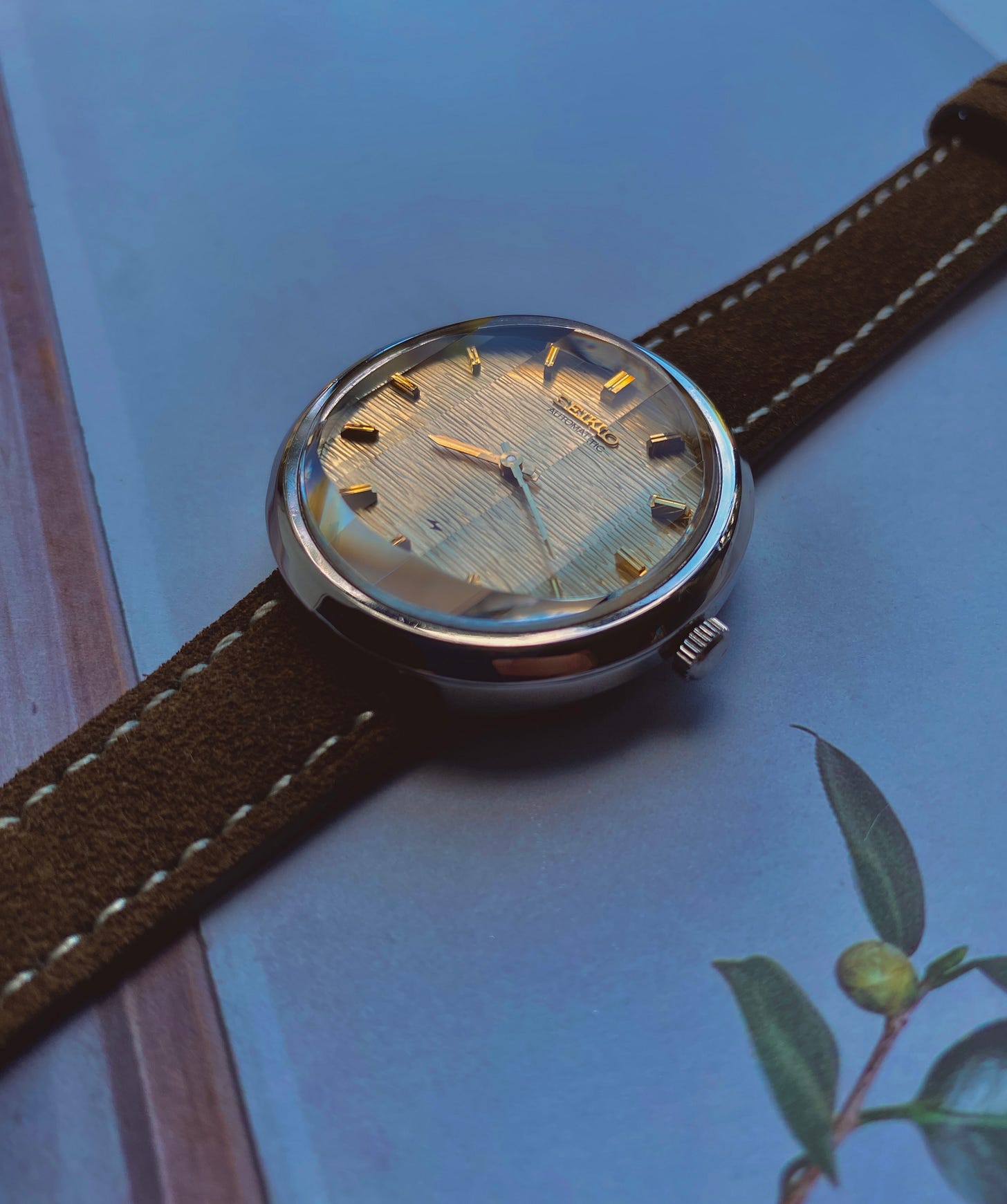

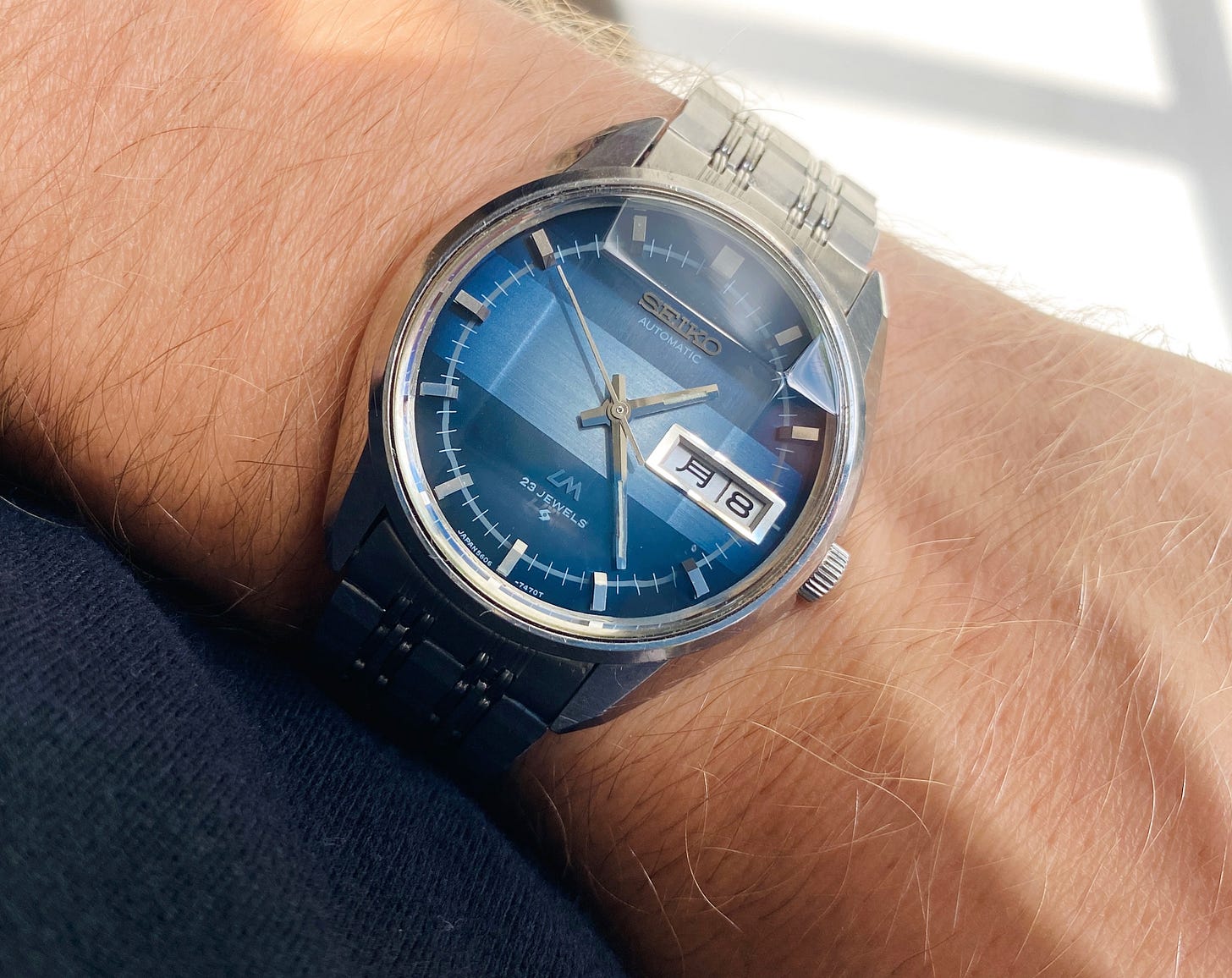
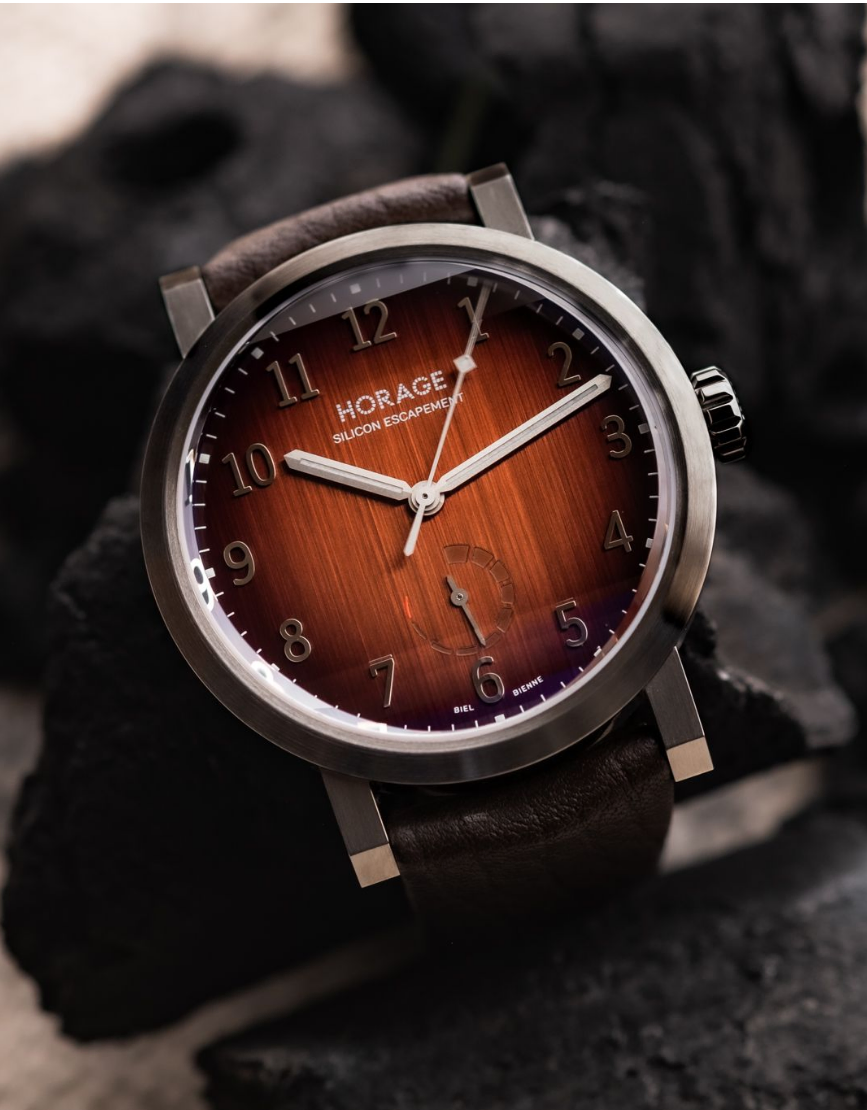
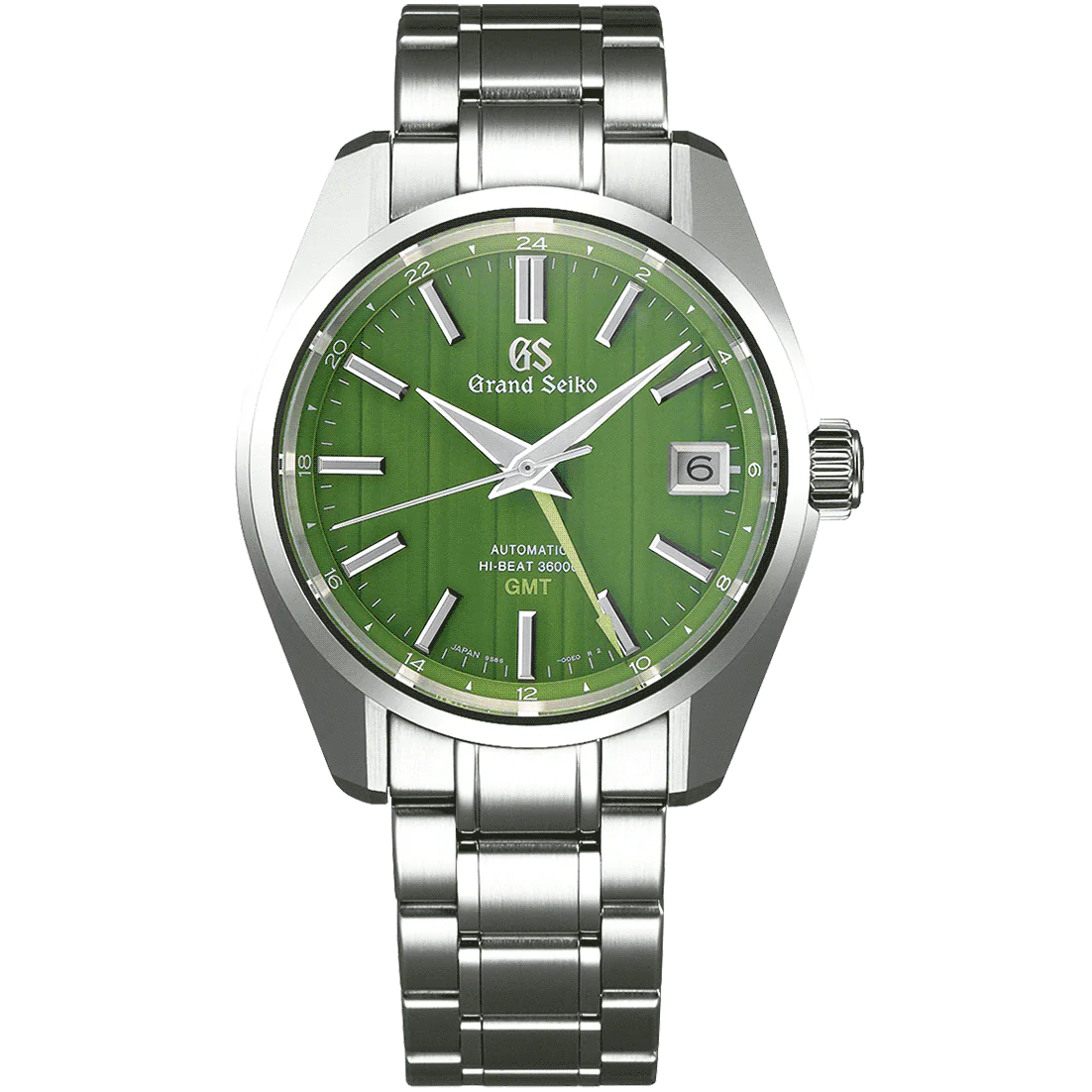
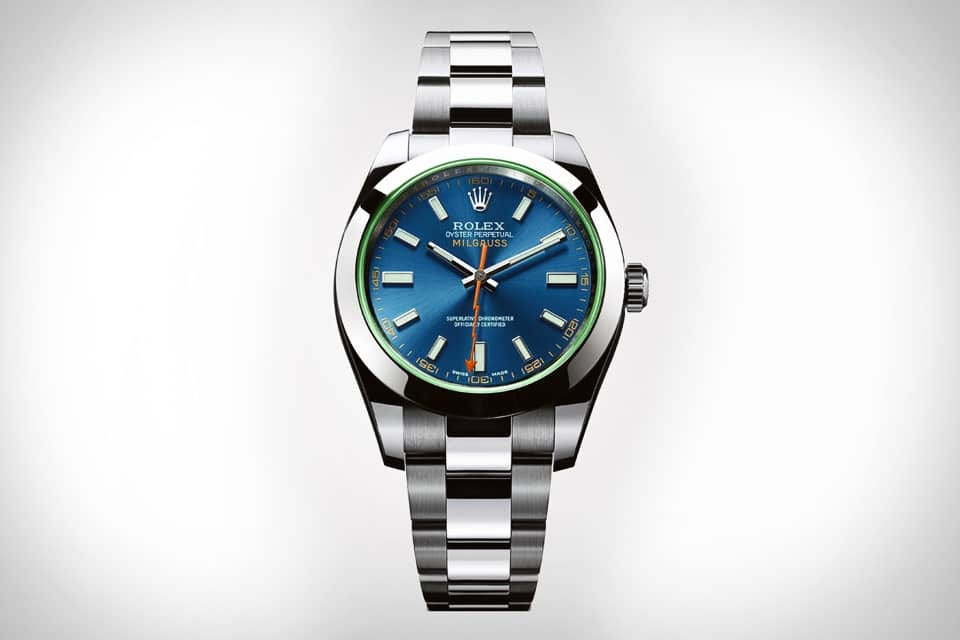
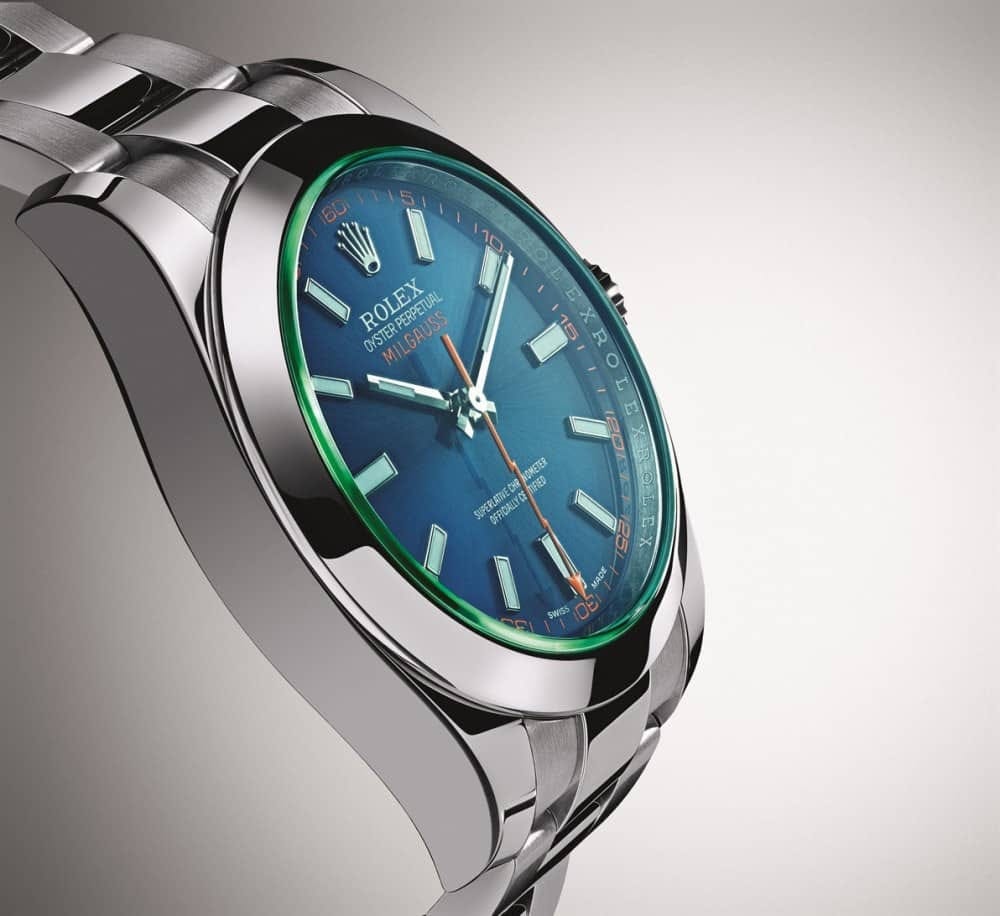
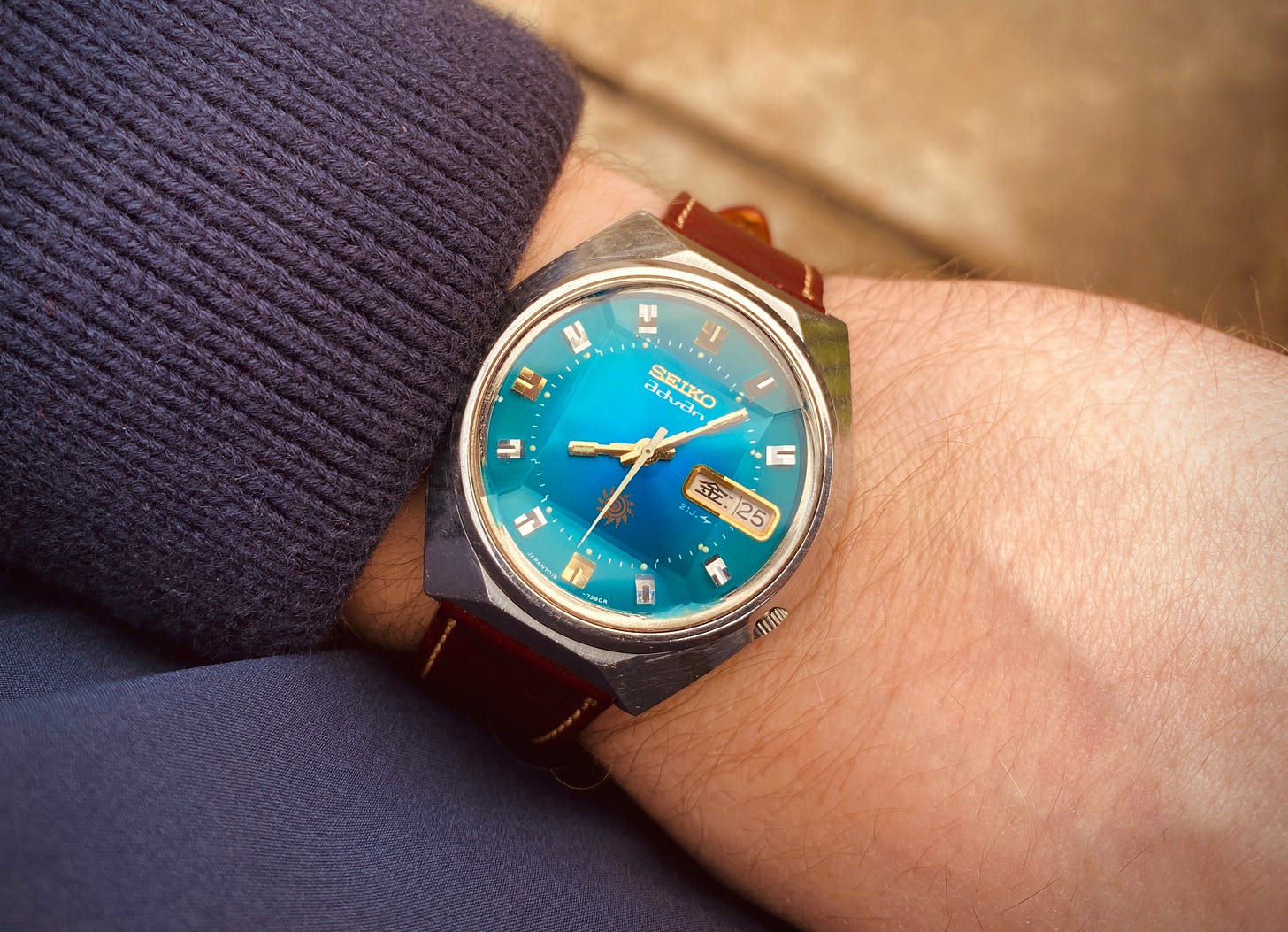

Very interesting read Mike loved it, hopefully one day I can find one they look fantastic never actually seen one 🥲🥲👊👌
Heath